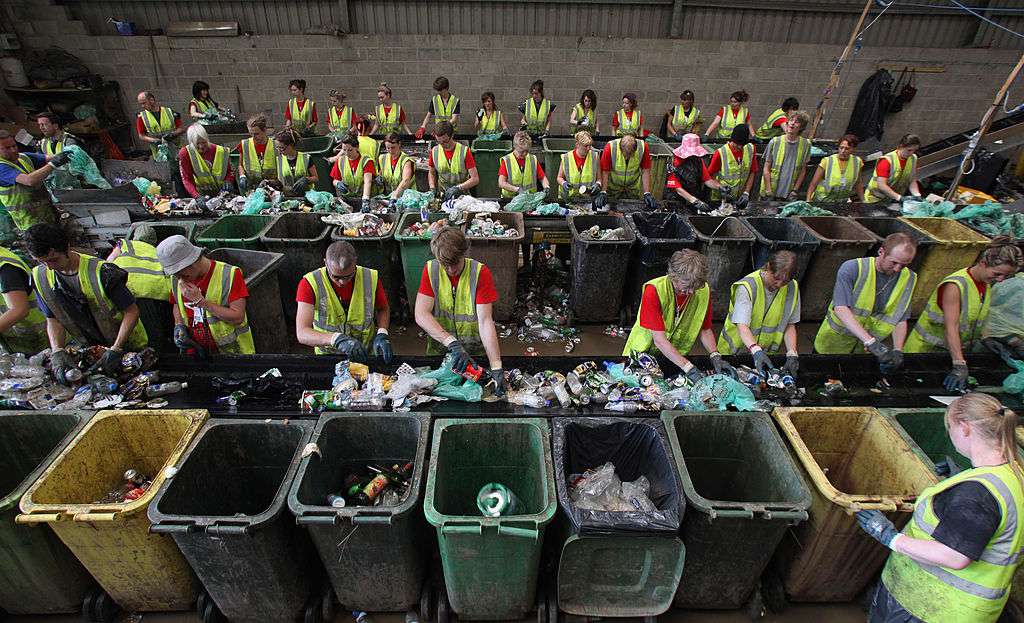
Commingled recycling, or single-stream recycling, is the system during which all plastic, metals, paper, and different recyclables are blended right into a single assortment truck. This implies residents don’t have to type these recyclables beforehand; they’re sorted by after they arrive at a cloth restoration facility (MRF).
The simplicity of this technique—simply put all of your recyclables in the identical bin—makes it all of the extra engaging to residents. Nonetheless, commingled recycling will not be with out its drawbacks. On this article, we’ll check out the method of this recycling system, some advantages and downsides, and the way it compares to different types of recycling.
How Commingled Recycling Works
Single-stream recycling started in the US within the Nineteen Nineties as a low-barrier entry into recycling; it was slowly adopted by communities throughout the nation.
Commingled recycling packages differ between townships. Many settle for recyclables within the following classes:
- Plastic merchandise (Townships might solely settle for plastics with particular resin identification codes.)
- Newspapers
- Paper and cardboard merchandise (might embrace magazines, cereal bins, clear egg cartons, and so forth.)
- Glass merchandise (might embrace clear food and drinks bottles, jars, containers, and so forth.)
- Metallic merchandise (might embrace clear aluminum foil, and so forth.)
Treehugger Tip
So as to decide if commingled recycling is offered in your neighborhood, it’s best to contact your native county or municipality. Moreover, verify I Need To Be Recycled, which may help you establish how objects will be recycled inside your neighborhood.
After recyclables are collected, the truck then brings them to the ground of an MRF, the place the sorting takes place. At many amenities, the supplies are first positioned on a conveyor belt the place MRF employees take away all of the non-recycling objects by hand. All of the objects that may be recycled are then transferred onto a collection of deck screens, which permits the heavier objects to drop by to the underside screens, leaving the lighter objects, corresponding to paper and cardboard, on the highest display screen.
The heavier objects are positioned below a magnet that removes all of the metallic. Staff will verify to make sure no objects are sorted into the flawed class. They then type the objects on the highest display screen into separate containers for paper, cardboard, and newsprint.
In spite of everything recyclable objects are within the right bins, they’re shipped to their respective recycling facility to be processed into new supplies.
Twin-Stream vs. Single-Stream Recycling
Whereas single-stream recycling entails placing all of your recyclables into one bin, dual-stream recycling makes use of two separate bins. Normally, plastic, glass, metallic, and different supplies go into one bin, whereas paper merchandise are collected in one other.
Twin-stream recycling requires a bit extra work on the buyer’s finish, as they have to type their recyclables earlier than assortment. Although it might seem to be a small process, this may deter individuals from recycling in any respect, or from doing so rigorously and accurately.
Execs and Cons of Commingled Recycling
Is commingled recycling extra environment friendly than dual-stream recycling? Like something, there are each advantages and downsides.
Execs
The principle advantage of commingled recycling is that it’s comparatively straightforward for customers to take part in curbside recycling packages. Likewise, commingled recycling can also be less expensive for the buyer as they solely should buy one recycling bin, and objects are picked up by a single truck. Consequently, this technique receives larger public approval in lots of states, corresponding to New Jersey.
Cons
Probably the most vital drawback of commingled recycling is the elevated threat of contamination amongst recyclables. Contaminated supplies might embrace objects that aren’t clear (corresponding to used meals or drink containers) or glass that has shattered on its solution to a facility. Gadgets which are contaminated both can’t be processed into a brand new recycled product, or the brand new product is of lesser high quality.
Plus, contaminated recyclables are liable to damaging MRF gear, which will be expensive for townships and amenities.
Commingled Recycling Ideas
Recycling total has its share of environmental drawbacks. Nonetheless, if you’re collaborating in a commingled recycling program, you may wish to guarantee you’re doing all your half in order that your recycled objects are correctly processed. Listed here are our prime suggestions:
- Make sure that any recyclable containers (whether or not glass, plastic, metallic, and so forth.) are clear.
- Test that each bottle and container is empty earlier than putting it within the bin.
- Learn labels on any objects which have additional recycling tips.
- Contact your township’s recycling division with any particular questions on supplies, recycling pick-up, and so forth.